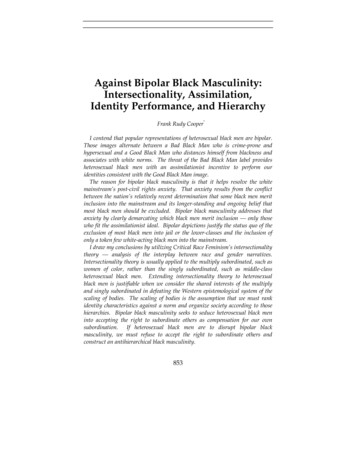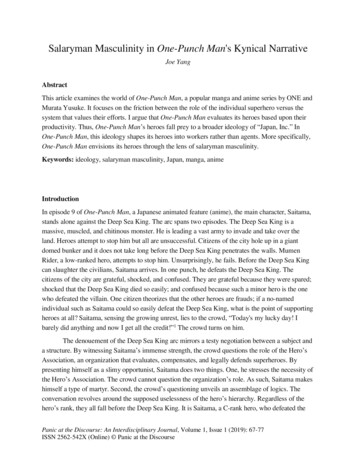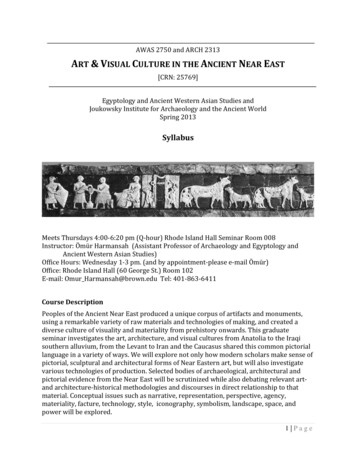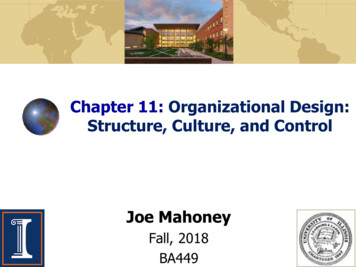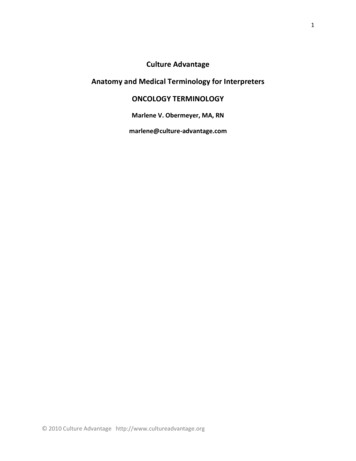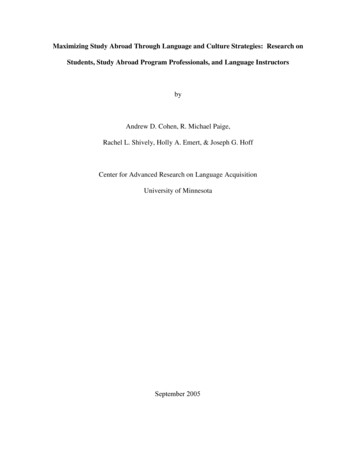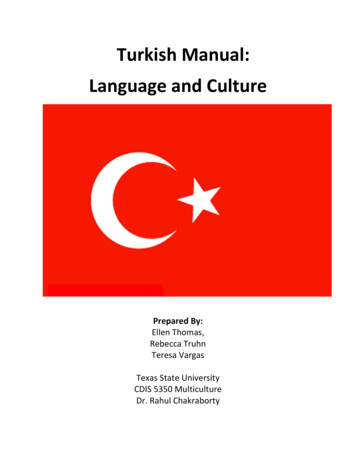
Transcription
Black Masculinity and Visual CultureAuthor(s): Herman GrayReviewed work(s):Source: Callaloo, Vol. 18, No. 2 (Spring, 1995), pp. 401-405Published by: The Johns Hopkins University PressStable URL: http://www.jstor.org/stable/3299086 .Accessed: 02/11/2012 09:42Your use of the JSTOR archive indicates your acceptance of the Terms & Conditions of Use, available at ms.jsp.JSTOR is a not-for-profit service that helps scholars, researchers, and students discover, use, and build upon a wide range ofcontent in a trusted digital archive. We use information technology and tools to increase productivity and facilitate new formsof scholarship. For more information about JSTOR, please contact support@jstor.org.The Johns Hopkins University Press is collaborating with JSTOR to digitize, preserve and extend access toCallaloo.http://www.jstor.org
BLACK MASCULINITY AND VISUAL CULTURE*by HermanGrayI want to inquire into the social circumstances and cultural conditions in whichcontemporary representations of black masculinity are produced and circulate.Recognizing the dense intertextual nature of electronic visual media, my aim is tounsettle as much as possible the formal and largely constructed ways in which we seeand understand visual representations of black masculinity. Much as one mightexperience them daily through ads, music television, television situation comedy,and sports, my desire is for this text, in effect if not in structure, to approximate thedense and relentless but always rich and increasingly inseparable experience of visualrepresentations of black masculinity.Self representations of black masculinity in the United States are historicallystructured by and against dominant (and dominating) discourses of masculinity andrace, specifically (whiteness).' For example, the black jazz men of the 1950s and 1960s,notably Miles Davis and John Coltrane, are particularly emblematic of the complexsocial relations (race, class, sexual) and cultural politics surrounding the self-construction and representation of the black masculine in the public sphere.2 As moderninnovators in musical aesthetics, cultural vision, and personal style, these menchallenged dominant cultural assumptions about masculinity and whiteness.And it was through their music and style that these (largely heterosexual blackmen) defined themselves in a racist social order. For many of us, jazz men articulateda different way of knowing ourselves and seeing the world through the very "structures of feeling" they assumed, articulated, and enacted-from the defiantly cool poseand fine vines of Miles to the black and third world internationalism that framed theceaseless spiritual and musical quest of Coltrane. Davis and Coltrane, like theircontemporaries, enacted a black masculine that not only challenged whiteness butexiled it to the (cultural) margins of blackness-i.e., in their hands blackness was apowerful symbol of the masculine.3This figure of the black jazz man was not without contradictions. As a "different"sign of the masculine he was policed as much as he was celebrated and exoticized bywhite men and women alike. Policed as a social threat because he transgressed thesocial role assigned to him by the dominant culture and celebrated as the "modernprimitive" because he embodied and expressed a masculinity that explicitly rejectedthe reigning codes of propriety and place. Drugs, sexism, pleasure, excess, nihilism,defiance, pride, and the cool pose of disengagement were all a part of the style,* Reprinted from the exhibition catalogue, BlackMale:Representationsof Masculinityin ContemporaryAmericanArt. Copyright X 1994, Whitney Museum of American Art, 945 Madison Avenue, NewYork, NY 10021.Callaloo18.2 (1995) 401-405
CA L L A L OOpersonality, vision, and practice of an assertive heterosexual black masculinity thatcould not be confined within the dominant cultural logic. (The lives and careers ofJohn Coltrane and Miles Davis illustrate the complex and wide-ranging relations ofgender at play in the jazz world; Coltrane's wife was a respected member of his band,while Davis often treated women with derision and abuse. My point is that, althoughthe masculinity created by the black jazz man at once challenged dominant whitediscourses of heterosexual masculinity, with respect to women this same powerfuland defiant black masculinity just as often maintained unequal relations of powerbetween men and women.4)These troubling and complex aspects of racial and gender politics continue withrespect to representations of black masculinity, from the romanticization of theoriginal gangsta (OG) and neo-nationalist in contemporary rap to the celebrations ofthe middle class in civil rights discourse. Contemporary images of black masculinitycontinue to challenge hegemonic constructions of whiteness even as they rewrite andreproduce forms of patriarchal authority, enveloping some of its most disturbingaspects in black vernacular style and expressive performance.5The political disturbances and cultural rearticulations of the black masculine theseimages produce require new contextualizations and different reading strategies.Black heterosexual masculinity is figured in the popular imagination as the basis ofmasculine hero worship in the case of rappers; as naturalized and commodifiedbodies in the case of athletes; as symbols of menace and threat in the case of black gangmembers; and as noble warriors in the case of Afrocentric nationalists and Fruit ofIslam. While these varied images travel across different fields of electronic representation and social discourse, it is nevertheless the same black body-super star athlete,indignant rapper, "menacing" gang member, ad pitch-man, appropriate middle classprofessional, movie star-onto which competing and conflicting claims about (andfor) black masculinity are waged.Like their jazz predecessors, contemporary expressions of black masculinity worksymbolically in a number of directions at once; they challenge and disturb racial andclass constructions of blackness; they also rewrite and reinscribe the patriarchal andheterosexual basis of masculine privilege (and domination) based on gender andsexuality.Consider how, for example, neo-conservatives used the black male body underReaganism. Black heterosexual masculinity was used in policy debates, in televisionnews, and popular film representations to link the signs of patriotism, whiteness,family, nation, and individual responsibility. Discursively located outside of the"normative conceptions," mainstream moral and class structure, media representations of poor black males (e.g., Rodney King and Willie Horton) served as thesymbolic basis for fueling and sustaining panics about crime, the nuclear family, andmiddle-class security while they displaced attention from the economy, racism,sexism, and homophobia. This figure of black masculinity consistently appears in thepopular imagination as the logical and legitimate object of surveillance and policing,containment and punishment. Discursively this black male body brings together thedominant institutions of (white) masculine power and authority-criminal justicesystem, the police, and the news media-to protect (white) Americans from harm.402
CCALLALOOWorking this heavily surveyed and heavily illuminated public arena, the figure ofthe menacing black male criminal body is also the object of adolescent intrigue,fascination, and adulation. Dr. Dre, Too Short, Ice-T, Ice Cube, Tupac Shakur, SnoopDoggy Dog, Old Dog (Menace II Society), and other rappers have used cinema andmusic video to appropriate this surveyed and policed space for different ends:namely, to construct or reconstruct the image of black masculinity into one of hyperblackness based on fear and dread.6 By drawing on deeply felt moral panics aboutcrime, violence, gangs, and drugs, these figures have attempted, often successfully, toturn dominant representations of black male bodies into a contested cultural field.Black rappers imaginatively rework and rewrite the historic tropes of black heterosexual, masculine (hyper)sexuality, insensitivity, detachment, and cold-bloodednessinto new tropes of fascination and fear.The cultural effects of these images are as complex as they are troubling. Thecomplex cluster of self-representations embodied in images of the black heterosexualbody as rapper, athlete, and movie star challenges racist depictions of black masculinity as incompetent, oversexed, and uncivil-ultimately a threat to middle classnotions of white womanhood, family, and the nation. But representations of the OG(and self-representations of black male youth more generally) are also underwrittenby definitions of manhood deeply dependent on traditional notions of heterosexuality, authenticity, and sexism.These very same images of black manhood as threat and dread not only work todisturb dominant white representations of black manhood, they also stand in aconflicted relationship with definitions and images of masculinity within blackness,most notably constructions of black masculinity produced by the middle-class wingof the civil rights movement and those produced more recently by black gay men. Inthe first instance, the OG as an emblem of black heterosexual male youth culturethreatens and challenges middle-class male (liberal and conservative) conceptions ofpublic civility, private morality, and individual responsibility. From this perspectiveone might see both the middle-class competence of Cliff Huxtable (motivated by theliberal politics of Bill Cosby) and Clarence Thomas as created by the same moment asthat which produced the demonization of black male youth. Both the real ClarenceThomas and the fictional Cliff Huxtable represent different sides of the same historical moment and do the same kind of recuperative work (in a different direction ofcourse) as that of black male rappers.7At the level of representation (and cultural politics) both Thomas and Huxtablework as black heterosexual male members of the middle class who challenge thedominant conceptions of black manhood as incompetent, irresponsible, over-sexed,and a threat to white notions of womanhood, family, and nation. Both Thomas andHuxtable are the realizations of citizen-subjects produced by the civil rights movement. And yet, like the image of masculinity advanced by the OG, the competencesand responsibilities of black heterosexual masculinity produced by the discourse ofcivil rights are organized by allegiances to the existing regime of patriarchy, heterosexuality, and gender relations. As episodes of The Cosby Show and clips of theThomas/Hill hearings demonstrate, there is little disturbance to the "patriarchalorder of things" where masculinity and manhood are concerned.403
CALLALOOMedia representations of black masculinity operate within the cultural politics ofblackness on yet another important (and for some) oppositional front. This figure ofblack masculinity marks the racial and cultural boundaries of a counter-hegemonicblackness which stands for the black nation, the black family, and the authentic black(male) self.8 In contemporary reconfigurations of the black nation, especially its mostvisible and aggressive guise-Afrocentricity (Leonard Jeffries), the Nation of Islam(Kalid Mohammed, Minister Louis Farakhan), nationalist-based hip-hop-it is theideal of the strong uncompromising black man, the new black man, the authenticblack man, which anchors the oppositional (and within a nationalist discourse)affirmative representation of black masculinity. (In light of insights by post-colonialcultural studies and feminist women of color, the persistence and strength of suchheterosexual masculinist-based neo-nationalism should give us pause to ponder therather uneven effects of such interventions at the level of theory and lived experience.)Despite the persistence of neo-nationalism and its dependence on a cultural logicthat views its subjects as monolithic, fixed, and authentic, contemporary conceptionsof heterosexual black masculinity in the United States are nevertheless open tochallenge from a variety of locations within the sign of blackness.Marlon Riggs' Tongues Untied (1989) and Marco Williams' In Searchof Our Fathers(1992) illuminate the contested character of this terrain of black heterosexual masculinity. These films, together with the episode of Roc featuring Richard Roundtree asa gay black man involved with a white lover, challenge and destabilize the monolithicand hegemonic character of images rooted in stable heterosexual black masculinityand essential notions of family and nation. The works offer different and morecomplex ways of seeing and imagining black masculinity and black collective identity. And it is this very complexity and vitality that represents new possibilities forseeing and experiencing our black male selves differently, especially insofar asbinaries like manhood/womanhood, black/white, gay/straight, high culture/lowculture, public/private, tv/film, commodification/authenticity become more andmore problematic and unstable. In their travels and circuits, contemporary images ofblack masculinity are necessarily engaged in the production of complex intertextualwork whose cultural meanings and effects are constantly shifting, open to negotiation, challenge, and rewritings.NOTES1. See GeraldEarly,TheCultureof Bruising:Essayson Hopewell, NJ:Ecco Press, 1994).2. One could easily add Duke Ellington, Charlie Parker, Max Roach, Dizzy Gillespie, LesterYoung, Charles Mingus, and Ornette Coleman to this list.3. Despite being a rather romantic and exotic look at black jazz men, RoundMidnight(1986) isnotable in large measure because it features jazz musicians like Dexter Gordon, Ron Carter,Bobby Hutchinson and others cast in screen roles as musicians.4. See Miles Davis, with Quincy Troupe, Miles: The Autobiography(New York: Sim
work as black heterosexual male members of the middle class who challenge the dominant conceptions of black manhood as incompetent, irresponsible, over-sexed, and a threat to white notions of womanhood, family, and nation. Both Thomas and Huxtable are the realizations of citizen-subjects produced by the civil rights move- ment. And yet, like the image of masculinity advanced by the OG,
